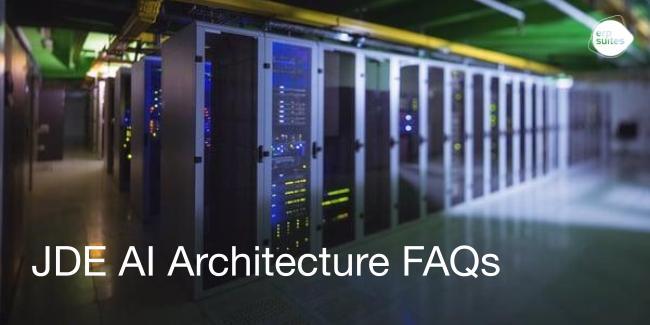The Cost of Implementing AWS Monitron in the Workplace
June 12th, 2024
5 min read
.png?width=960&height=540&name=Blog%20Images%20(46).png)
Whether you’re an IT manager for an on-prem data center or a warehouse manager for an electronics company, you know how crucial it is to keep your machinery running smoothly. Unexpected equipment failures can not only halt operations, but they can also have long-term ramifications like supply chain disruptions. But predicting when something might go wrong can feel like trying to forecast the weather – different every day. This is where a machine monitoring tool like AWS Monitron comes in, offering a predictive maintenance solution that promises to save time, money, and stress.
At ERP Suites, we understand the challenges you face daily. We’ve been there, and we’ve seen the impact of equipment downtime on productivity and morale. In this article, we’ll break down the potential costs associated with implementing AWS Monitron, giving you a clear picture of what to expect.
By the end, you’ll have a comprehensive understanding of the investment required and the potential benefits, allowing you to make an informed decision for your business.
What is AWS Monitron?
AWS Monitron is an end-to-end machine monitoring solution designed to help businesses detect potential equipment failures before they happen. It is proprietary to Amazon Web Services (AWS) and can be used by anyone. Monitron leverages the power of machine learning to provide accurate real-time insights into the health of your machinery. Like other machine monitoring tools, AWS Monitron encompasses a network of factors that work together, from physical sensors to gateways to a machine learning algorithm to data integration with other systems and ERPs.
Breakdown of AWS Monitron Hardware Expenses
The first step in implementing AWS Monitron is purchasing the necessary hardware, which includes sensors and gateways.
Starter Kit
The AWS Monitron starter kit comes with five sensors and one gateway, priced at around $715. This kit is designed to get you up and running quickly, providing the basic tools needed for initial setup and monitoring.
Gateway Options
You have two types of gateways to choose from: Wi-Fi and wired. While Wi-Fi gateways offer flexibility in placement, wired gateways are generally more stable and less prone to communication outages. The choice between them will depend on your specific needs and environment. You may also need a certain speed, so keep that consideration in mind when pricing out potential options.
Additional Sensors
Depending on the size of your operation, you might need to purchase more sensors. AWS Monitron offers the ability to purchase sensors in multiples of 5, allowing you to scale your monitoring system as needed. The typical life of an Amazon Monitron sensor battery is five years. Up to 20 Amazon Monitron sensors can be connected at a time with one Amazon Monitron gateway.
Ex-Rated Sensors
For hazardous locations, such as areas with gases or classified as Class 1/Zone 2, ex-rated sensors are necessary. These specialized sensors are designed to operate safely in environments that standard sensors cannot.
AWS Monitron has the following options for device purchases:
- Amazon Monitron Starter Kit: five Amazon Monitron Sensors (TE1A001) and one Amazon Monitron Gateway
- Five pack of Amazon Monitron Sensors (TE1A001)
- Five pack of Ex-rated Amazon Monitron Sensors (TE1A195)
- One Amazon Monitron Gateway (Wi-Fi)
- One Amazon Monitron Gateway (Ethernet)
Installation and Setup Costs
Once you have your hardware, the next step is installation and setup. If you perform this task in-house, you can account for the cost within your capital or expense budget, depending on your structure. If you outsource installation and set-up, the costs will vary depending on who you select as your partner.
Physical Installation
Mounting the sensors and gateways is the first task. This process involves placing the sensors on the equipment you want to monitor and positioning the gateways to ensure optimal communication. While this can be a straightforward task, it requires attention to detail to ensure reliable data collection.
Network Integration
Connecting the gateways to your company’s network is crucial. This step involves configuring network settings and ensuring that the gateways can communicate effectively with AWS Monitron’s cloud services.
Sensor Pairing and Dashboard Configuration
After the hardware is installed, you’ll need to pair the sensors with the gateways and configure the AWS Monitron dashboard. This includes creating assets to monitor, naming and describing sensors, and setting up reports. For a basic setup with five sensors, this process might take about an hour. However, as you become more familiar with the system, subsequent setups should be quicker.
Monthly Service Fees
In addition to the initial setup costs, there are ongoing monthly service fees associated with AWS Monitron. These are distinct from management or operational costs.
Per-Sensor Fees
Each sensor incurs a monthly fee for the Monitron service, which covers data collection, processing, and reporting. The exact amount varies, but it typically ranges around $50 per sensor per year.
Additional AWS Services
To fully utilize AWS Monitron’s capabilities, you might need to subscribe to other AWS services. These services facilitate data integration, alerting, and advanced analytics.
Operational Costs and Maintenance
Maintaining an AWS Monitron system involves various ongoing costs and tasks.
Battery Replacement
As mentioned above, Monitron sensors come with batteries that typically last about five years. Over time, you’ll need to replace the sensors as the batteries expire, since the batteries cannot be replaced. Costs may vary over a sensor’s lifespan.
Regular Monitoring and Upkeep
Regularly monitoring the system and performing routine maintenance is essential. This includes checking sensor status, reviewing alerts, and ensuring that the system is functioning correctly. You can hire out this service or lower your costs and keep it in-house.
Customizing Alerts and Thresholds
AWS Monitron allows you to set custom alert thresholds based on your specific needs. This customization helps reduce false alarms and ensures that alerts are meaningful and actionable.
Integration with Existing Systems
One of the significant advantages of AWS Monitron is its ability to integrate with existing systems, such as JD Edwards EnterpriseOne (JDE).
Custom Orchestrations
Integrating Monitron alerts with JDE requires custom orchestrations. This involves creating workflows that can consume Monitron data and generate maintenance work orders in JDE. The level of integration depends on your JD Edwards specifications. If you are utilizing the Capital Asset Management (CAM) module, you’ll get more automation from the machine monitoring, but you’ll have more setup. While this adds to the setup cost, it streamlines maintenance processes and reduces manual intervention.
Cost Savings from Automation
Automating the maintenance workflow can lead to significant cost savings. By reducing the need for manual data entry and ensuring timely responses to alerts, you can minimize unplanned downtime and enhance operational efficiency.
Use Case Example: Implementing AWS Monitron in a Factory
Let’s consider a real-world example to illustrate the process and benefits of implementing AWS Monitron. At ERP Suites, we are implementing AWS Monitron in our data center as part of a use case for understanding how a machine monitoring system like this works, how we can help advise our customers on their own prospective predictive maintenance solutions, and how AWS Monitron specifically works.
Initial Setup and Deployment
We started by purchasing and installing five sensors and one gateway in our data center. After a successful initial setup, we added five more sensors, bringing the total to ten. The installation process involved physically mounting the sensors, connecting the gateway to our network, and configuring the Monitron dashboard.
Handling Alerts and Maintenance Work Orders
When AWS Monitron detects an issue, it can send an alert that triggers a maintenance work order in JDE. Our maintenance crew receives the alert, investigates the issue, and takes appropriate action. If necessary, they can hold subsequent alerts until the initial issue is resolved, preventing duplicate work orders.
Assessing the Impact on Maintenance Operations
By using AWS Monitron, we’ve been able to proactively address potential equipment failures, reducing downtime and improving overall efficiency. The system’s machine learning capabilities have also helped us refine alert thresholds, minimizing false alarms and ensuring that maintenance resources are used effectively.
Value Proposition and ROI
Implementing AWS Monitron offers several benefits that contribute to a positive return on investment (ROI).
Reducing DowntimeBy predicting potential equipment failures, AWS Monitron helps prevent unexpected downtime. This proactive approach reduces maintenance costs and extends the lifespan of your equipment.
Unplanned downtime can be costly, both in terms of lost productivity and repair expenses. AWS Monitron’s alerts enable timely interventions, minimizing the impact of equipment issues on your operations.
Long-Term Savings
While there are initial setup costs and ongoing fees, the long-term savings from reduced downtime, efficient maintenance, and extended equipment lifespan can be substantial.
Start Your AWS Monitron Journey Today
Implementing AWS Monitron in the workplace is an investment that offers significant benefits. From initial setup and monthly service fees to integration with existing systems and long-term savings, this article has provided a comprehensive overview of the costs involved. By understanding these costs and the value proposition of predictive maintenance, you can make an informed decision that enhances your operational efficiency and reduces downtime.
At ERP Suites, we’re here to support you every step of the way. Whether you need help with setup, integration, or ongoing maintenance, our team of experts is ready to assist. Contact us to schedule a Smart Manufacturing Readiness Assessment and we can discuss a timeline for implementing machine monitoring.
Leyla Shokoohe is an award-winning journalist with over a decade of experience, specializing in workplace and journalistic storytelling and marketing. As content manager at ERP Suites, she writes articles that help customers understand every step of their individual ERP journey.



.png?width=650&height=325&name=Blog%20Images%202_1%20(4).png)
.png?width=650&height=325&name=Blog%20Images%202_1%20(5).png)
.png?width=650&height=325&name=Blog%20Images%202_1%20(3).png)
.png?width=650&height=325&name=Blog%20Images%202_1%20(2).png)
.png?width=650&height=325&name=Blog%20Images%202_1%20(1).png)
.png?width=960&height=540&name=Blog%20Images%20(96).png)

.png?width=960&height=540&name=Blog%20Images%20(90).png)
.png?width=960&height=540&name=Blog%20Images%20(88).png)
.png?width=960&height=540&name=Blog%20Images%20(87).png)
.png?width=960&height=540&name=Blog%20Images%20(86).png)
.png?width=960&height=540&name=Blog%20Images%20(85).png)
.png?width=960&height=540&name=Blog%20Images%20(83).png)
.png?width=960&height=540&name=Blog%20Images%20(82).png)
.png?width=960&height=540&name=Blog%20Images%20(80).png)